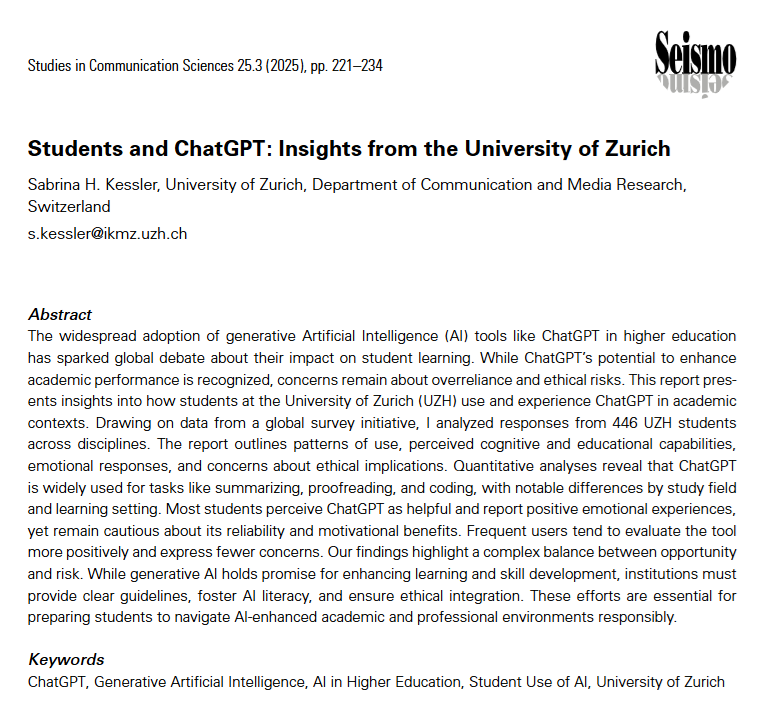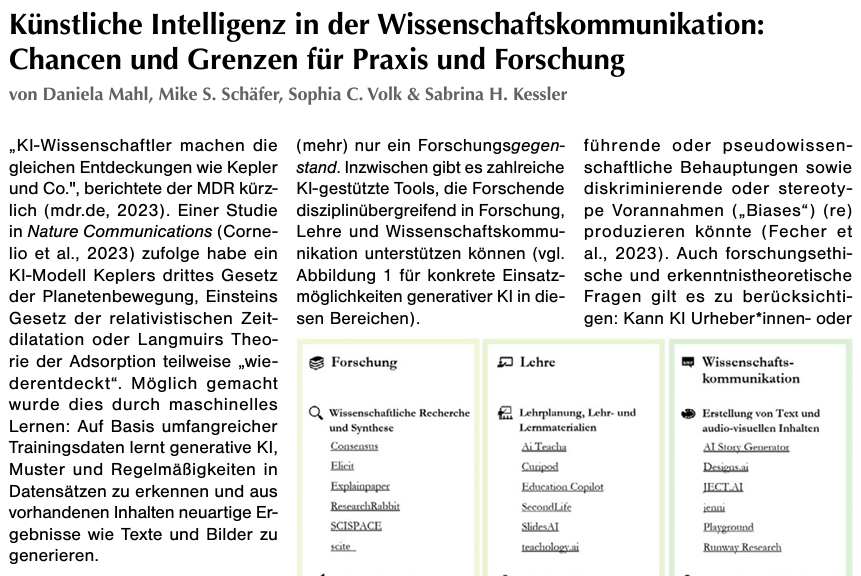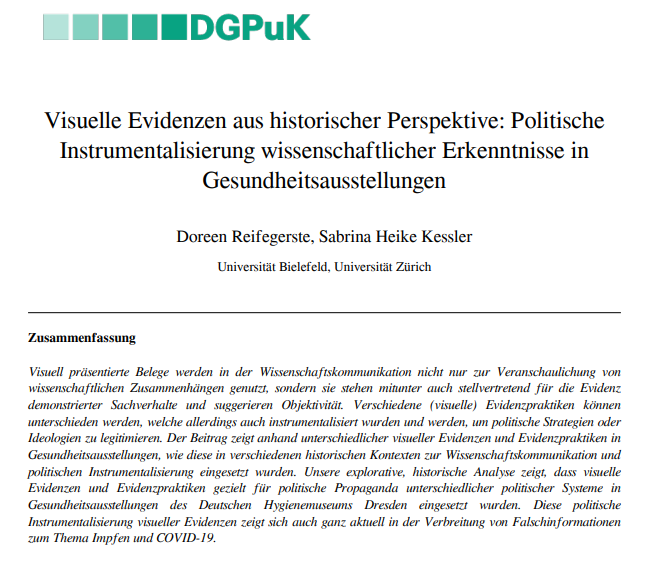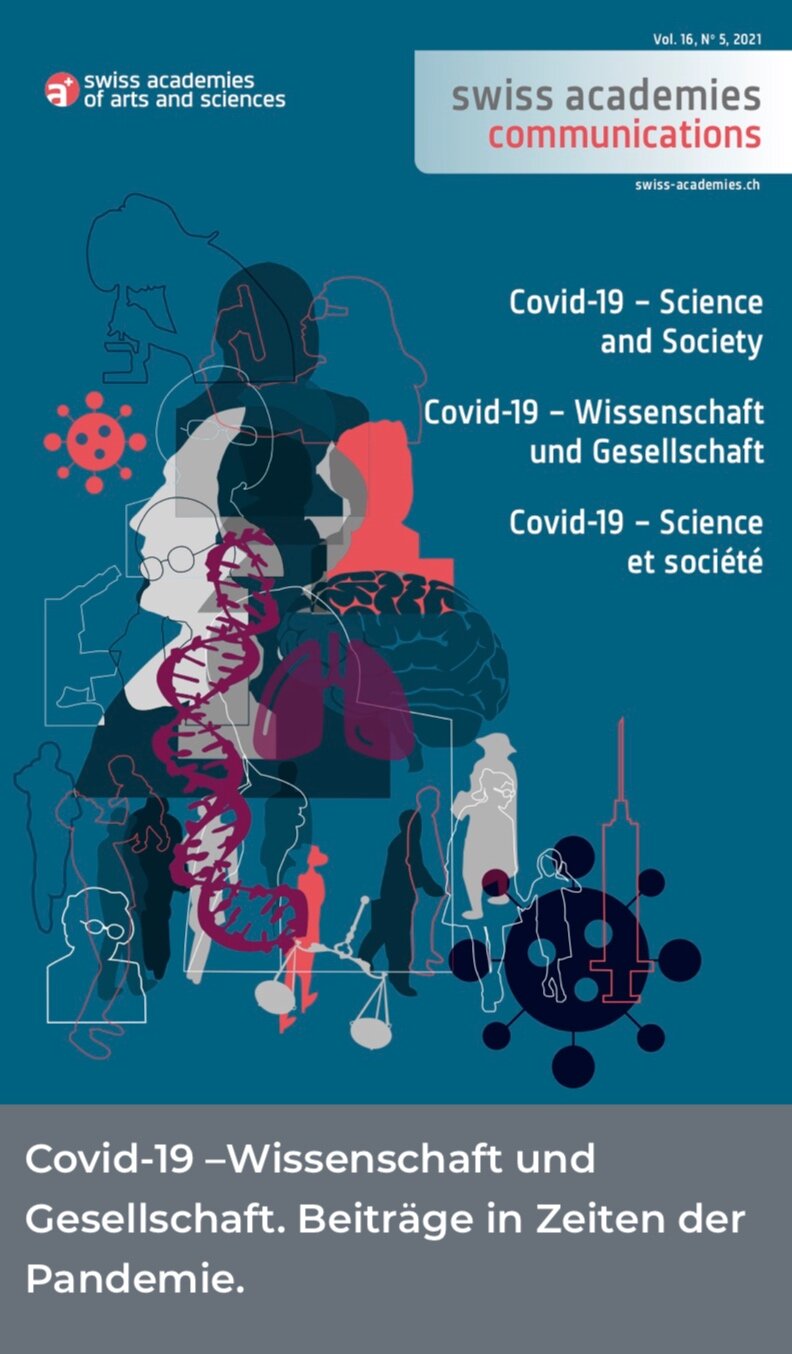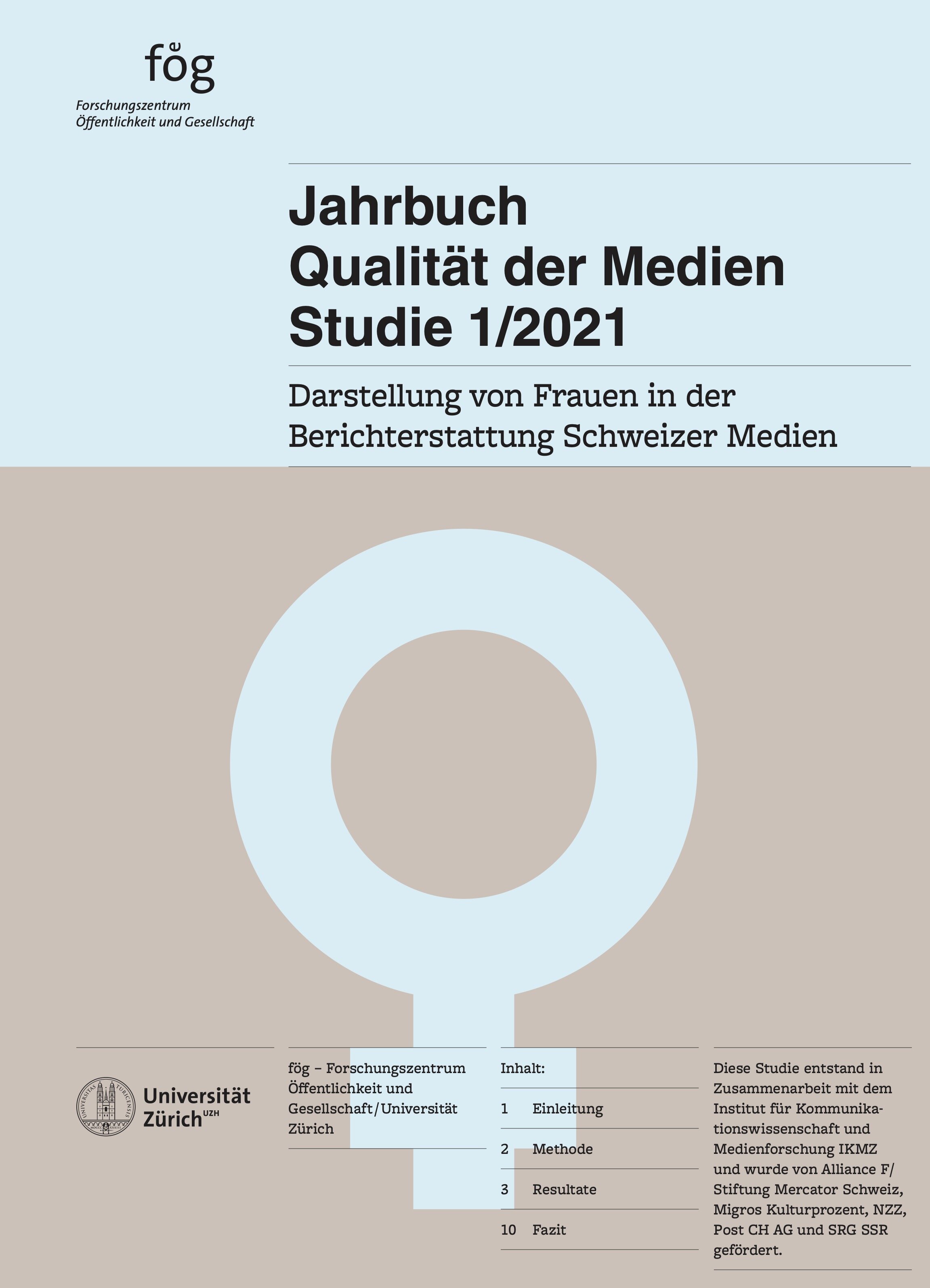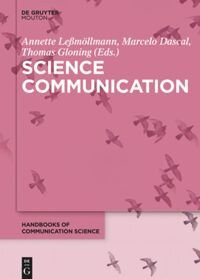Articles in encyclopaedias, handbooks, edited books, and conference proceedings
Students and ChatGPT
Kessler, S. H. (2025). Students and ChatGPT: Insights from the University of Zurich. Studies in Communication Sciences, 25(3), 221–234. https://doi.org/10.24434/j.scoms.2025.03.7300
The widespread adoption of generative Artificial Intelligence (AI) tools like ChatGPT in higher education has sparked global debate about their impact on student learning. While ChatGPT’s potential to enhance academic performance is recognized, concerns remain about overreliance and ethical risks. This report presents insights into how students at the University of Zurich (UZH) use and experience ChatGPT in academic contexts. Drawing on data from a global survey initiative, I analyzed responses from 446 UZH students across disciplines. The report outlines patterns of use, perceived cognitive and educational capabilities, emotional responses, and concerns about ethical implications. Quantitative analyses reveal that ChatGPT is widely used for tasks like summarizing, proofreading, and coding, with notable differences by study field and learning setting. Most students perceive ChatGPT as helpful and report positive emotional experiences, yet remain cautious about its reliability and motivational benefits. Frequent users tend to evaluate the tool more positively and express fewer concerns. Our findings highlight a complex balance between opportunity and risk. While generative AI holds promise for enhancing learning and skill development, institutions must provide clear guidelines, foster AI literacy, and ensure ethical integration. These efforts are essential for preparing students to navigate AI-enhanced academic and professional environments responsibly.
Fake News and Misinformation in Health Communication
Kessler, S. H. (2025). Fake News and Misinformation. In G.-J. de Bruijn & H. Vandebosch (eds.), Handbook of Health, Media, and Communication (pp. 453-468). Berlin: De Gruyter. https://doi.org/10.1515/9783110775426-024
This chapter explores the pervasive issue of health-related misinformation and fake news, particularly during the COVID-19 pandemic. It defines key terms, examines how misinformation spreads, and discusses its prevalence and impact on public health. The chapter highlights the role of social media in the rapid dissemination of false information and investigates the reasons behind the public’s belief in such misinformation. Consequences of believing in health misinformation are addressed, including negative impacts on health behaviors and public trust. The chapter also reviews various strategies to combat misinformation, such as debunking, nudging, andprebunking, and emphasizes the need for comprehensive approaches to strengthen individual and societal resilience. Future research directions are suggested, focusing on underexplored areas and the generalizability of findings beyond the COVID-19 context. This comprehensive analysis underscores the importance of combating health misinformation to protect public health.
Mahl, D., Schäfer, M. S., Volk, S. C., & Kessler, S. H. (2024). Künstliche Intelligenz in der Wissenschaft: Chancen und Grenzen für Forschung, Lehre und Wissenstransfer. [Artificial intelligence in science: Opportunities and limits for research, teaching and knowledge transfer]. Ze-phir, 31(1), 24-26.
Kessler, S. H. & Wicke, N. (2023). Grundlagenbeitrag: Inhaltsanalysen inkl. Medienanalysen. [Basic contribution: Content analyses including media analyses]. In P. Niemann, V. van den Bogaert, & R. Ziegler (Hrsg.), Evaluationsmethoden der Wissenschaftskommunikation. Wiesbaden: Springer VS. DOI: 10.1007/978-3-658-39582-7_14
Der Grundlagenbeitrag fokussiert auf die Methode der Inhaltsanalyse inkl. Medienanalyse und reflektiert den Einsatz dieser im Bereich der Evaluation von Wissenschaftskommunikation. Nachdem einleitend deren Relevanz reflektiert wird, wird diese vorgestellt, indem Untersuchungsgegenstände, Analyseprozesse und Ziele der quantitativen/standardisierten und qualitativen Inhaltsanalyse erläutert werden. Herausgearbeitet werden dann die Analyseschwerpunkte der Inhalts- und Medienanalysen im Bereich der Evaluation von Wissenschaftskommunikation und ihrer Begleitforschung. Diese sind u. a. (1) Modi der Wissenschaftskommunikation, (2) die Genauigkeit der Berichterstattung, (3) die Darstellung, das Framing und die Bewertung von Wissenschaft und wissenschaftlichen Erkenntnissen, und (4) Dialogizität und Funktionalität der Wissenschaftskommunikation bzw. Funktionen der Öffentlichkeitsarbeit. Im letzten Punkt wird ein Ausblick gegeben und relevante Forschungslücken werden herausgestellt.
Reifegerste, D., & Kessler, S. H. (2022). Visuelle Evidenzen aus historischer Perspektive: Politische Instrumentalisierung wissenschaftlicher Erkenntnisse in Gesundheitsausstellungen. [Visual evidence from a historical perspective: Political instrumentalization of scientific findings in health exhibitions.] In A. M. Scheu, T. Birkner, C. Schwarzenegger, & B. Fähnrich (Hrsg.), Wissenschaftskommunikation und Kommunikationsgeschichte: Umbrüche, Transformationen, Kontinuitäten (S. 1-13). Münster: Deutsche Gesellschaft für Publizistik- und Kommunikationswissenschaft e.V. DOI: 10.21241/ssoar.83502
Visuell präsentierte Belege werden in der Wissenschaftskommunikation nicht nur zur Veranschaulichung von wissenschaftlichen Zusammenhängen genutzt, sondern sie stehen mitunter auch stellvertretend für die Evidenz demonstrierter Sachverhalte und suggerieren Objektivität. Verschiedene (visuelle) Evidenzpraktiken können unterschieden werden, welche allerdings auch instrumentalisiert wurden und werden, um politische Strategien oder Ideologien zu legitimieren. Der Beitrag zeigt anhand unterschiedlicher visueller Evidenzen und Evidenzpraktiken in Gesundheitsausstellungen, wie diese in verschiedenen historischen Kontexten zur Wissenschaftskommunikation und politischen Instrumentalisierung eingesetzt wurden. Unsere explorative, historische Analyse zeigt, dass visuelle Evidenzen und Evidenzpraktiken gezielt für politische Propaganda unterschiedlicher politischer Systeme in Gesundheitsausstellungen des Deutschen Hygienemuseums Dresden eingesetzt wurden. Diese politische Instrumentalisierung visueller Evidenzen zeigt sich auch ganz aktuell in der Verbreitung von Falschinformationen zum Thema Impfen und COVID-19.
Kessler, S. H. (2022). Online Medical Consultation Services. In E. Ho, C. Bylund, & J. von Weert (eds.). The International Encyclopedia of Health Communication. New Jersey: Wiley. DOI: 10.1002/9781119678816.iehc0620
Online medical consultation services (also called “e-consultation” or “e-visit” services) are Internet-based remote patient–doctor (consumer–provider) services from different hospitals and medical institutes; these are a part of telemedicine (telehealth or e-health) usually for the purpose of diagnosis or treatment. Research has identified various reasons for and purposes of the use of the patient-centered services and, in particular, examined patient inquiries in relation to diseases mentioned in the requests, health narratives and included emotions, and the new doctor–patient relationship. Online medical consultation services can strengthen patient empowerment and health literacy through the individual provision of health information and greatly impact the use of health systems, patient–doctor roles and relations, and individuals' health. They are increasing in popularity, especially in the time of the COVID-19 pandemic.
Kessler, S. H. (2022). Eye-Tracking. In E. Ho, C. Bylund, & J. von Weert (eds.). The International Encyclopedia of Health Communication. New Jersey: Wiley. DOI: 10.1002/9781119678816.iehc0599
Eye-tracking methodologies are becoming a common research tool for those in the field of health communication research. The process-tracking method allows researchers to collect an objective assessment of visual behavior. Eye movements and positions are seen as indicators of the uptake of visual information that provide insights into the cognitive processes underlying a wide variety of human health communication and information-related behaviors. Most health communication studies using eye tracking were conducted in the USA, relied on remote/stationary eye trackers, used eye tracking mostly in combination with a survey, and had small sample sizes consisting mostly of university or high school students. The studies often analyzed the effect of stimuli on different dependent variables. The most used stimulus type was static (e.g., images or websites). The most frequently used dependent variable was attention. Attention is a crucial antecedent to the persuasive intent of many health-related messages, studied by scholars seeking to understand how to promote healthy behavior.
Kessler, S. H. & Schäfer, M. S. (2022). Content Analyses in Science Communication Research. In F. Oehmer, S. H. Kessler, E. Humprecht, K. Sommer, & L. Castro Herrero (eds.), Standardisierte Inhaltsanalyse in der Kommunikationswissenschaft – Standardized Content Analysis in Communication Research. Wiesbaden: Springer. DOI: 10.1007/978-3-658-36179-2_15
Science communication has been defined as encompassing “all forms of communication by and about the sciences, within science (professional audience) as well as in the [broader] public sphere (general audience)”. This broad understanding of science communication includes all kinds of communication focusing on scientific work or scientific results, within science or to non-scientists, in one-directional or dialogical form. It also includes communication about the natural sciences, the arts or the humanities, and it has considerable overlaps with research fields such as health communication and risk communication. Content analysis, especially of media content, is a common method in the research field and this article provides an overview of this research.
Kessler, S. H., Sommer, K., Humprecht, E., & Oehmer-Pedrazzi, F. (2022). Manuelle standardisierte Inhaltsanalyse [Manual standardized content analysis]. In F. Oehmer, S. H. Kessler, E. Humprecht, K. Sommer, & L. Castro Herrero (eds.), Standardisierte Inhaltsanalyse in der Kommunikationswissenschaft – Standardized Content Analysis in Communication Research. Wiesbaden: Springer. DOI: 10.1007/978-3-658-36179-2_2
Die manuelle Inhaltsanalyse gilt nach wie vor als zentrale Methode kommunikationswissenschaftlicher Forschung. Die nachfolgenden Ausführungen sollen ein Grundverständnis über Merkmale, Schritte, Qualitätskriterien und Schwerpunkte der manuellen Inhaltsanalyse vermitteln, die für die Nachvollziehbarkeit von Konzept und Idee des Handbuchs behilflich sein können. So wird in diesem Kapitel deutlich, was unter standardisierter Inhaltsanalyse – auch in Abgrenzung zur qualitativen Inhaltsanalyse – verstanden wird. Zudem werden auch Qualitätskriterien der manuellen Inhaltsanalyse skizziert, die bei der Auswahl der berichteten Studien in diesem Handbuch und auch der Operationalisierungen für die dazugehörige Datenbank zentral waren.
Reifegerste, D. & Kessler, S. H. (2022). Digitales Self-Tracking aus historischer Perspektive [Digital Self-tracking from a Historical Perspective]. In C. Schwarzenegger, E. Koenen, C. Pentzold, T. Birkner & C. Katzenbach (eds), Digitale Kommunikation und Kommunikationsgeschichte: Perspektiven, Potentiale, Problemfelder [Digital Communication and Communication History: Perspectives, Potentials, Problem Areas] (pp. 249–273). Berlin: Digital Communication Research.
Digitale Selbstvermessung (Self-Tracking) ist integraler Bestandteil vieler digitaler gesundheitsbezogener Kommunikationstechnologien und wird intensiv genutzt. Während sich die GesundheitswissenschaftlerInnen auf die Chancen dieser Anwendungen für die Gesundheitsförderung und -versorgung konzentrieren, warnen bspw. die KulturwissenschaftlerInnen vor den Risiken der technisierten Selbstbeobachtung. Anhand der historischen Vorläufer der digitalen Selbstvermessung wird aufgezeigt, mit welchen Chancen (z. B. für die Gesundheitserziehung) und Risiken (z. B. politische Instrumentalisierung) diese in verschiedenen politischen Kontexten verbunden waren. Die historische Reflexion wird dann zur normativen Diskussion aktueller digitaler Selbstmessungsentwicklungen herangezogen, um zu betrachten, welche Chancen und Risiken das digitale Self-Tracking für Individuen und Gesellschaft haben kann.
Kessler, S. H. & Langmann, K. (2021). Online-Recherche und Selektionsprozesse zur politischen Wissensbildung: Eine Eye-Tracking-Untersuchung zur Informationssuche nach Parteipositionen im Internet. [Online search and selection processes for political knowledge generation: An eye-tracking study on online information searches for party positions]. In M. Seifert & S. Jöckel (Hrsg.), Bildung, Wissen und Kompetenz(-en) in digitalen Medien. Was können, wollen und sollen wir über digital vernetzte Kommunikation wissen? (S. 137-157). Berlin: Digital Communication Research. doi: 10.48541/dcr.v8.8
Wie Menschen online nach politischen Informationen suchen, bestimmt entscheidend darüber, welche Informationen rezipiert werden und in der Konsequenz über das generierte Wissen. Das Suchverhalten in Bezug auf politische Informationen und der Einfluss verschiedener Personenmerkmale auf das resultierende Wissen ist jedoch weitgehend unerforscht. Diese Studie zielt darauf ab, mit einem multimethodischen Design zu untersuchen, wie Menschen (N = 44) online nach politischen Parteienpositionen suchen und welches Wissen sie generieren. Mit fünf Suchaufgaben pro Probandin und Proband (N = 220 Suchaufgaben) wurden das Such- und Auswahlverhalten mittels Eye-Tracking analysiert. Es folgte eine Inhaltsanalyse der Eye-Tracking-Daten und der Antworten zum generierten Wissen. Die Ergebnisse zeigen, dass sich die Online-Suchen je nach Suchaufgabe nur in wenigen Aspekten unterscheiden. Das resultierende Wissen ist nicht für alle Suchaufgaben einheitlich und mitunter vom konkreten Suchverhalten abhängig.
Kessler, S. H., Jobin, A., Grüninger, S., & Georgi, F. (2021), Was können wir aus Covid-19 Fake News über die Verbreitung von Fehlinformationen im Allgemeinen lernen? Ein Projekt der Swiss Young Academy. [What can we learn from Covid-19 Fake News about the spread of misinformation in general? A project of the Swiss You Academy]. Swiss Academies Communications, 16(5), 68-75.
[Founded in 2020, the Swiss Young Academy (SYA) connects members of the academic middle classes from all scientific disciplines. It forms an inspiring environment for inter- and transdisciplinary encounters, collaborations and innovative ideas. The members are contact persons for Swiss science in the national and international context and are considered the young voice of the Swiss Academies of Arts and Sciences. The core tasks of the Junge Akademie Schweiz include the representation of the academic middle class and the promotion of scientific and socio-political discourse, as well as the implementation of inter- and transdisciplinary group projects at the interfaces of science and society.]
Schwaiger, L., Vogler, D., Fürst, S., Kessler, S. H., Humprecht, E., Schweizer, C. & Rivière, M. (2021). Darstellung von Frauen in der Berichterstattung Schweizer Medien. [Representation of women in Swiss media coverage]. In fög – Forschungszentrum Öffentlichkeit und Gesellschaft (Hrsg.), Jahrbuch Qualität der Medien. Basel: Schwabe.
[In this study, we examine the representation of women in Swiss media coverage. We use two sub-studies to show how the media representation of women and men has changed since 2015 and how women and men are portrayed in the media. Our results show that women are still significantly underrepresented in Swiss media compared to men. For every mention of a woman, there are around three mentions of men (share of women: 23%). This disparity exists in all Swiss language regions and across all media types, with slight differences. The values differ somewhat more at the level of individual media. Depending on the medium, the proportion of women is between 19% and around 29%. An improvement in terms of equal representation was only seen in 2019, which was marked by Women's Strike Day as a media and social event. However, this positive change evaporated again in 2020. In particular, clear gender differences can be seen with regard to the topic areas and contribution formats. The largest gender gap is in business news (17% share of women) and sports news (13% share of women). The smallest gender gap is in cultural reporting (27% women's share) and human interest topics (31% women's share). Political reporting is in between (23% share of women). The format of the report also plays a role: the presence of women is twice as high in editorial reporting compared to media reports based on agency reports. If journalists can invest resources and write articles themselves, the media presence of women is positively influenced. This is in line with the finding that women are more present in person-centred formats than in reports and news. Men are also more often portrayed in professional roles and leadership positions. The higher the hierarchical level, the more pronounced the gender gap. For example, the proportion of women in top management functions is 17%, in the theming of people in simple management functions 22%, and in the theming of people at staff level 27%. The differences are smaller when it comes to reporting on people in private contexts. When private matters are reported, the proportion of women is 33%. When professional/public contexts are discussed, the share of women is 24%. Overall, our results highlight existing gender inequalities in Swiss media reporting and the need for future action for journalism in Switzerland.]
Zillich, A. F., & Kessler, S. H. (2019). Measuring selective exposure to online information. Combining eye-tracking and content analysis of users’ actual search behavior. In C. Peter, T. Naab, & R. Kühne (Hrsg.), Measuring media use and exposure: Recent developments and challenges (S. 196-220). Köln, GER: Halem.
Internet users are increasingly able to select messages that are in line with their existing attitude and to avoid counter-attitudinal information. When measuring selective exposure to online information, scholars have mainly applied self-reports and behavioral measurements such as log file analysis or eye-tracking. However, the typical research design represents neither ordinary online search behavior nor ordinary online articles and has limited ecological validity. The present study attempts to address some of these methodological shortcomings: We first compare the advantages and disadvantages of established methods for measuring selective exposure to online information. We then present an experimental study in which participants could search the Internet for information on vaccinations for a virtually unlimited period and recorded their actual selection behavior via eye-tracking. The viewed content, recorded by the eye-tracker, was subsequently coded in a content analysis on four analytical levels.
Schäfer, M. S., Kessler, S. H., & Fähnrich, B. (2019). Analyzing science communication through the lens of communication science: Reviewing the empirical evidence. In A. Lessmöllmann, M. Dascal, & T. Gloning (Hrsg.), Science Communication (S. 77-104). Berlin: de Gruyter.
From the 1960s onwards, communication scientists have analyzed science communication. This article provides an overview of the empirical evidence that this research has generated. First, it describes the structures of the research field based on available meta-analyses. Then, it describes what is known about the communicators of science (such as scientists, journalists, PR experts, NGOs, and others) and about the portrayals of science in news media as well as online and in social media, and exam-ines what is known about the uses and effects of science communication. For each of these subfields, the questions in focus, typical theoretical approaches, main results, and gaps are identified and reflected upon. In addition, the article identifies research gaps and potential avenues for future research.
Legrand, M., Kessler, S. H., & Eisenreich, C. (2019). Politische Inhalte liken, teilen und im Internet lesen: Zum Begriffsverständnis von politischer Online-Partizipation. [Liking, sharing and reading political content on the internet: On the conceptual understanding of online political participation]. In I. Engelmann, M. Legrand, & H. Marzinkowski (Hrsg.), Politische Partizipation im Medienwandel (S. 53-76). Berlin. DOI: 10.17174/dcr.v6.3.
[This article addresses possible differences in the academic and social understanding of the term online political participation. The basis for the comparison is a deductive analysis of existing definitions of online political participation at the intersection of communication and political science literature and a subsequent online survey. In addition to similarities, differences also emerge: Scholars identify, for example, creativity and effectiveness in online participation. From the citizens' point of view, the term already includes the reflected and serious engagement with political content and, moreover, forms a central criterion for distinguishing it from online political pseudo-participation. An expansion of the scientific definition is not recommended if different forms and normative qualities of online political participation are taken into account depending on the situation.]
Kessler, S. H., Reifegerste, D. & Guenther, L. (2016). Die Evidenzkraft von Bildern in der Wissenschaftskommunikation. [The evidence power of images in science communication]. In G. Ruhrmann, S. H. Kessler, & L. Guenther (Hrsg.), Wissenschaftskommunikation zwischen Risiko und (Un)Sicherheit (S. 171-192). [Science communication between risk and (un) certainty]. Köln: Herbert von Halem.
[Perceptual-psychological studies have shown that pictures sometimes capture attention more strongly than spoken text. They can convey highly complex information that cannot easily be expressed so quickly and simply by linguistic symbols (ARSENAULT/SMITH/BEAUCHAMp 2006; GEISE 2011; LOHOFF 2008). As a means of evidence, pictorial representations have for centuries contributed to conveying scientific knowledge in particular (HESSLER 2004). Almost all scientific results, events and phenomena are still presented today with the help of visualisations (ADELMANN/HENNIG/HESSLER 2008; ARSENAULT/SMITH/BEAUCHAMp 2006; RöSL 2008). Images are indispensable in many areas of research and also in science communication (ADELMANN/HENNIG/ HESSLER et al. 2008; HESSLER 2004; LOHOFF 2008).]
Ruhrmann, G., Kessler, S. H. & Guenther, L. (2016). Zwischen fragiler und konfligierender Evidenz: Wissenschaftskommunikation zwischen Risiko und (Un)Sicherheit. [Between fragile and conflicting evidence: science communication between risk and (in)security]. In G. Ruhrmann, S. H. Kessler & L. Guenther (Hrsg.), Wissenschaftskommunikation zwischen Risiko und (Un)Sicherheit (S. 10-38). [Science communication between risk and (un) certainty]. Köln: Herbert von Halem.
[The press, radio and online media are increasingly reporting on science, technology and their consequences. Recently, the scientific (in)safety of the underlying research has become the focus of public attention. Not only researchers are talking about it, but also the press, television and the internet are reporting on it. Risks are then quickly mentioned. Not only in medical and natural science research, but also in social and behavioural science research, there is a struggle to achieve scientific results that are as evidenced as possible. This is often associated with a complex methodological debate about research designs and the empirical results achieved in each case. It forms an essential core of every discipline and also indicates the respective scientific progress. However, the broad, non-scientifically educated public often perceives this discussion prevailing in science as a controversy, even as a dispute between scientists, and consequently also as a risk. Scientific results are not infrequently presented by journalists in an absolutely assured, one-sided and thus unreflected or unfiltered manner. This happens not least so that they appear more exciting for the audience and can be consumed more easily. What is the task and role of journalism in communicating science and its findings? How do journalists deal with scientific uncertainty and evidence? Can public relations work ensure more sustainable acceptance of basic research, but also of its possible consequential risks? How is scientific evidence, uncertainty and risk communicated in the mass media, both in writing and in pictures? How do different representations affect the recipients? What journalistic quality can be attributed to the respective contributions and reports? Can changes in the quality of science communication be detected? These are questions that this volume addresses in detail. It presents selected contributions from the 2nd Annual Conference of the Ad Hoc Group on Science Communication of the German Society for Journalism and Communication Studies (DGPuK). It took place in 2015 at the Friedrich Schiller University of Jena with the participation of numerous representatives from science, journalism and public relations.]
Reifegerste, D., Kessler, S. H. & Guenther, L. (2016). Bewegt durch Bilder? Der Einfluss von Aufmerksamkeit und Hintergrundmotiv. [Moved by images? The influence of attention and background theme]. In A.-L. Camerini, R. Ludolph & F. B. Rothenfluh (Hrsg.), Gesundheitskommunikation im Spannungsfeld zwischen Theorie und Praxis (S. 131-141). Reihe Medien + Gesundheit. Baden-Baden: Nomos.
[Regular physical activity is one of the most effective preventive measures to prevent a variety of health risks (Warburton, Nicol, & Bredin, 2006). Evaluations show that mass media campaigns can be used to increase an individual's physical activity (Leavy, Bull, Rosenberg, & Bauman, 2011). However, it is unclear what type of messaging strategies are most effective. To date, research on prevention messages to promote physical activity has focused primarily on the text of advertisements (e.g. Latimer, Brawley, & Bassett, 2010; Priebe & Spink, 2012) and has largely neglected visual messages. This is all the more surprising as images are indeed frequently used in physical activity campaigns (Berry, McCarville, & Rhodes, 2008) and have so far proven effective for other health communication topics (Houts, Doak, Doak, & Loscalzo, 2006).]
Guenther, L., Bader, C., Kessler, S. H. & Ruhrmann, G. (2015). Journalistische Wahrnehmung und Darstellung von (Un)Sicherheiten, Risiken und Chancen von Zukunftstechnologien. [Journalistic perception and presentation of (un) certainties, risks, and opportunities of future technologies]. In H. Bonfadelli, S. Kristiansen, & M. S. Schäfer (Hrsg.), Wissenschaftskommunikation im Wandel (S. 205-231). [Science communication in flux] Köln: Herbert von Halem.
